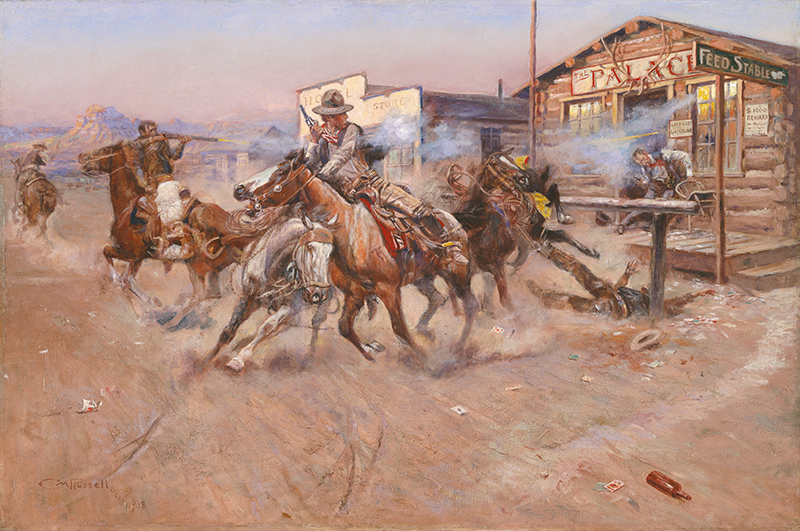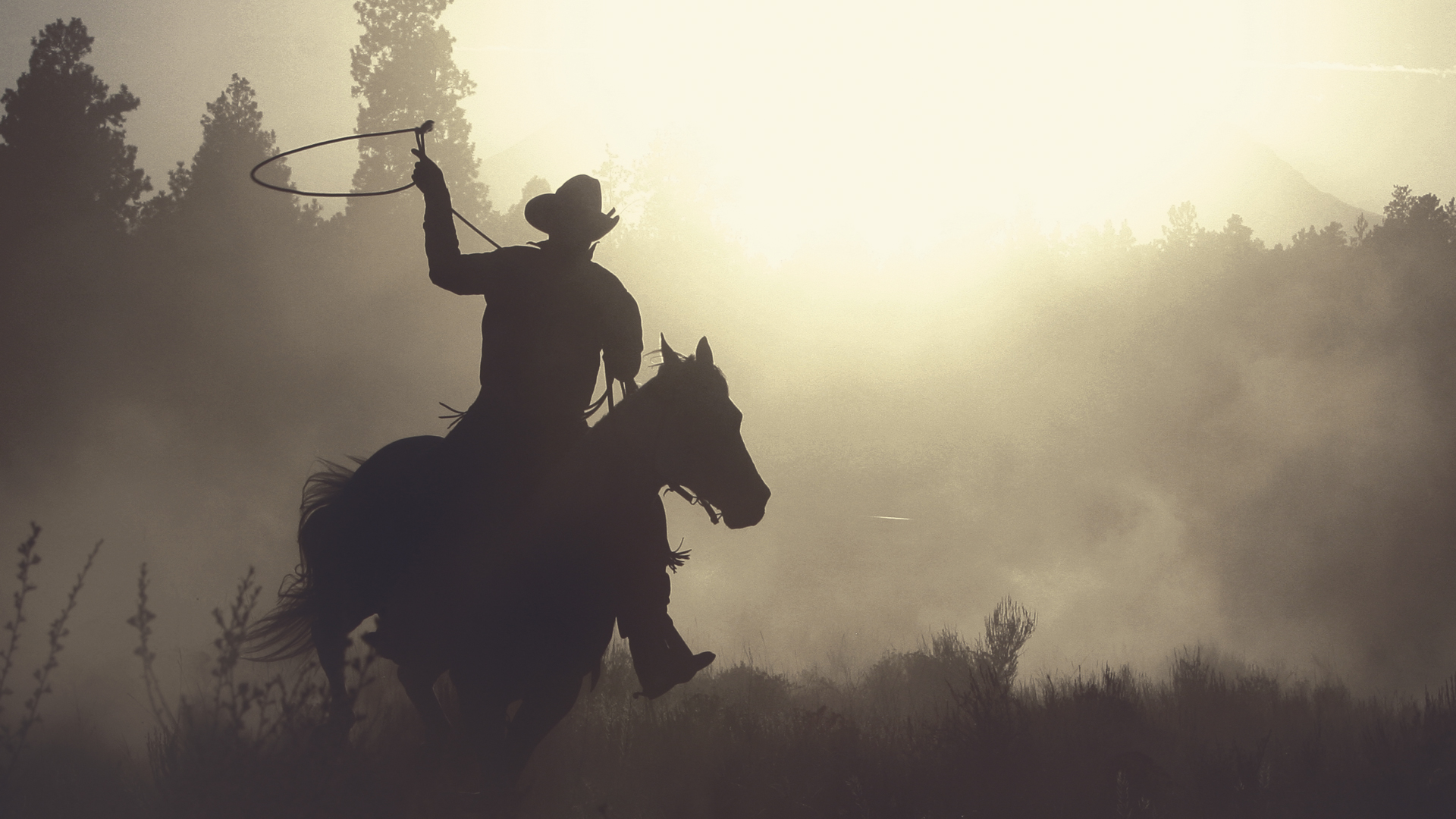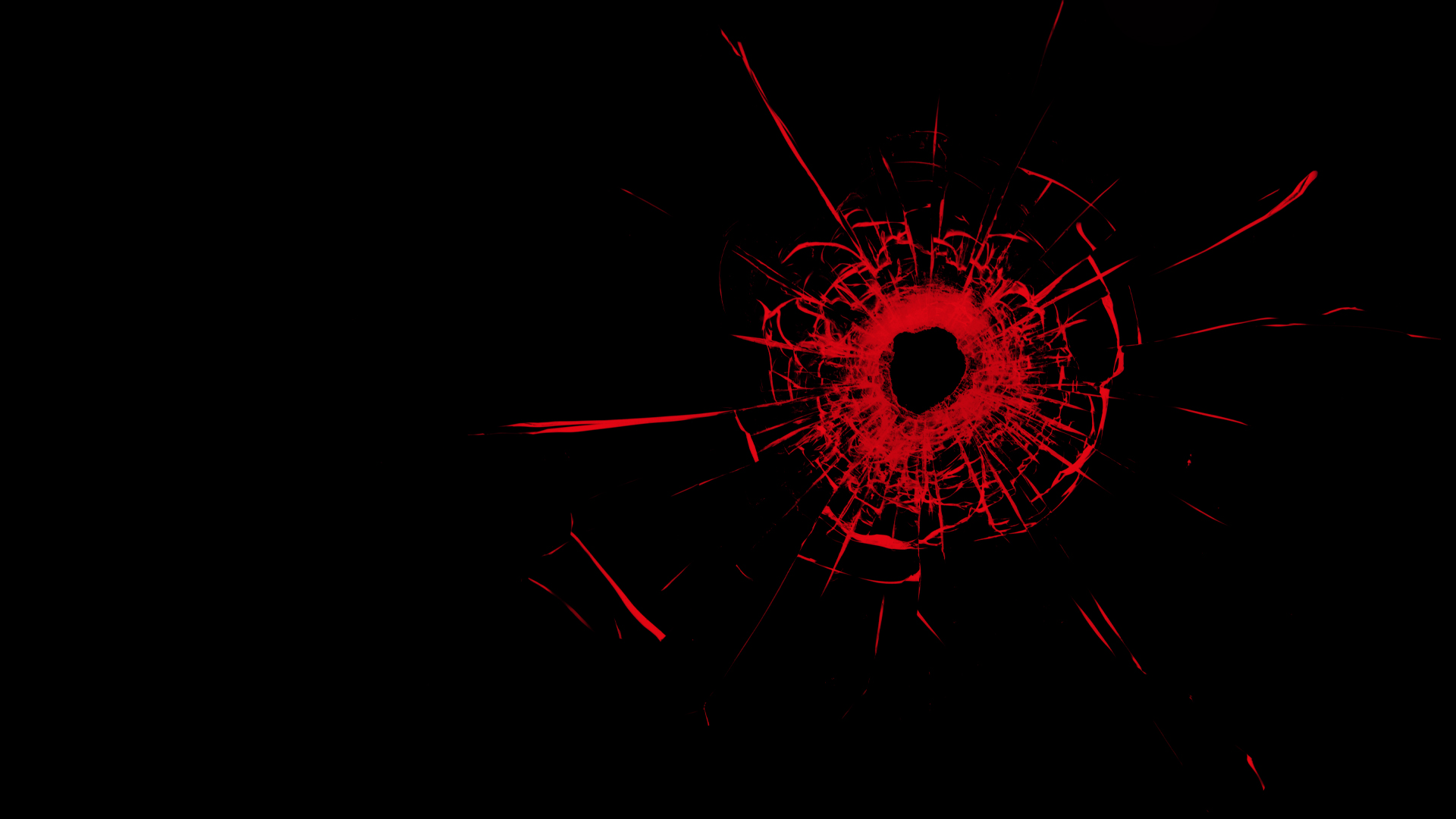From Cowboys to Sacred Cows
The Surprising Legacy of the Western Film Genre
From silent movies to “talkies” to television and beyond, the western film genre has helped shape American culture and, by extension, global culture.
Justin A. Joyce, Ph.D., is an interdisciplinary scholar of literature and film and the author of Gunslinging Justice: The American Culture of Gun Violence in Westerns and the Law. In this interview with Vision’s Gina Stepp, he discusses the far-reaching cultural legacy of the western film genre and how it plays out in popular views of justice, masculinity, individual liberty and more.
GS In your book you talk about the influence of the American western film genre on the law, and how we got to the self-defense doctrines we have. How does this relate to non-American readers?
JAJ Part of my approach in writing this book was to narrow things down and focus on one tradition. We’re doing bad scholarship and really bad critical interpretation when we assume that one culture’s paradigm for justice and violence applies to everybody else. So, I wanted to limit my remarks to the American notions of masculinity, justice, gun violence and legal paradigms. You’ll also see in Gunslinging Justice that I deliberately avoid the phrase, “the law.” Using “the law” presumes that there is only one legal system, but there are all kinds of ways and methods for adjudicating right and wrong. So instead of “the law,” I’m using phrases like “legal paradigms” or “legal systems.” My narrowing in on the American western genre is part of the same effort toward specificity.
However, we can’t deny or underestimate the impact of the American filmmaking machine on global culture. Hollywood learned how to make movies by making westerns. And the rest of the world adapted their movie cultures by watching Hollywood. The cultures, understandings, backgrounds and archetypes of what it takes to be a man, what it takes to be just, and what vengeance looks like are certainly going to be very different in different cultures and different traditions. But if they’re on horseback and have cowboy hats and guns, then they’re borrowing from a known American western tradition.
GS You write about the connections between guns and the American legal system as a “fabric,” because with so many threads it’s hard to pull out just one without taking others with it. Ideologically, how did guns become so important to us?
JAJ I approached the book to look at all these things that are related to American gun culture and ask how they come together and how can we pull them apart; that’s why I used the metaphor of the different threads in the fabric. So, how did we get here? First of all, we have a notion of a sovereign individual; the idea of indivisible individual rights just seems guaranteed, granted, especially to middle-class Anglo-Americans. But it’s important to think about what an incredible historical, philosophical and ideological rupture the American Revolution really was. To say “There is no sovereign authority; each individual is sovereign” is radically different than a monarchy—a complete change. In some ways the culture of violence in America is the logical conclusion of that, because in a monarchical system, the Crown holds the monopoly on violence. Individuals are not allowed to do this.
“Most Western legal systems try really hard to put some sort of third party between the person wronged and the person being punished, so that it’s not personal.”
If I steal your car, you don’t get to put me in jail. A third party does that. But the logical conclusion of individual sovereignty is that the individual can mete out justice.
The next thing is the American culture of expansion and capitalist development. The westward push during the 19th century necessitates a certain amount of individual autonomy and, well, individual violence—whether it’s violence against the indigenous people or against the land. (“This open meadow, or this forest—I’m going to make this my farm”). There’s very literal violence in that push. There’s also the capitalist idea of “It’s mine because I tilled, cultivated, developed it; therefore I get to sell it and profit from it.” This reinforces the idea of the sovereign individual.
Then our American legal system develops in such a way that we’re allowed to stand our ground and defend ourselves with lethal violence.
And the final thing I’ll add is the American notion of masculinity; it gets all tied up into the other three—this whole expression of manhood, of being able to mete out justice and violence. We take all of that and add an incredibly persuasive and well-funded firearm industry and firearm lobby that works really hard to make sure our legal system keeps everybody able to buy guns.

Justin A. Joyce, author of Gunslinging Justice: The American Culture of Gun Violence in Westerns and the Law (2018)
That’s one of many answers of how we get here. And I didn’t even talk about what a good chunk of Gunslinging Justice is about, which is the whole narrative archetype of the western and the western gunslinger that supports all these other things! We’ve been making western movies for more than a hundred years, and we still make them. And all of that goes together to get this portrait or ideal where if someone says, “You know, maybe we shouldn’t allow fully automatic assault rifles,” then suddenly the opposition proclaims, “You’re gonna take all the guns away! This is the most terrible, un-American thing ever!”
Reasonable gun control is met with wildly unreasonable objection because of all these strands put together.
GS In the book you talk about the western Shane, and how throughout that movie you’re given the idea that it’s okay for one man to decide who’s good and who’s bad, and kill off the bad. It seems like a dangerous concept.
JAJ Our gun violence statistics over the last—pick your time period—have roundly demonstrated that it is a dangerous notion. There is no arguing that. The only argument becomes whether or not that’s a certain amount of loss that’s acceptable. I don’t think anybody could argue with a straight face and a reasonable thinking mind that this is not a dangerous notion. Every statistic you can pull demonstrates that it is. The question is, how much danger are we willing to accept?
GS How do you pull back from the idea that it’s okay for one person to decide what justice looks like when it’s such a complex and layered concept and has been in our psyche for so long?
JAJ If I knew that answer, I’d be writing a different kind of book. As much as I was trained to be (and try to be) interpretively objective about the things I’m thinking and reading and writing about, I’m also a product of this culture. I was born and raised in the United States, so these expectations and notions of justice are very much ingrained. I quoted an author, Terry Aladjem, who said that when Americans want justice, they want something angry and punitive.
“As much as I can think critically about this, if I’m honest, when I feel I’ve been harmed or aggrieved in a certain way, my knee-jerk reaction is for anger and punitive justice.”
GS In America it’s almost like gun culture and religious culture have merged in recent years. You see signs that say things like “Protected by God and guns.” But if somebody believes in God, why do they need a gun? Why do those two cultures seem to be so married to one another right now? Is there a connection to western films in that as well?
JAJ Yes, there is a connection—certainly in the classic Hollywood moments of, say, pre-1968. Until 1968, there’s a certain production code and hegemony among the studios and directors. Many of them are very conservative, pushing the idea of a white, Christian America. And we see this in a reoccurring generic trope in westerns of the building of a church; you have this frontier settlement, and it doesn’t really become a town until they build a church. That’s one of a lot of reoccurring visual and narrative metaphors where the founding of a community leads to the founding of a church.
I would push back on the way you phrased the question when you said, “Why is it like that now?” The connection between American identity and Christianity of a very aggressive evangelical sort has been part of our founding history—and the United States has been using Christianity as a cover for all kinds of violence for a long time. The slave trade is a horrifically perfect example. So much of what was allowed to happen to an entire group of individuals was justified through the idea of “They’re not Christian.”
That’s not even talking about the distinction made between the indigenous peoples on this continent versus the European settlers that pushed westward and moved these folks out, labeling them as “heathen savages” because they’re not Christian.
So there’s a long, very detailed history of Christianity being used as a hypocritical cover for American violence.
GS Manifest Destiny.
JAJ Absolutely. In most elementary schools today, they still teach that the United States was founded as a Puritan colony, even though many of the original 13 colonies were not religious. Then we had the 1980s marriage between economically and politically conservative groups and religious groups, which now manifests itself in the sort of signage you’re seeing, even though vengeance is supposed to be the Lord’s. So why “God and guns”? It’s an ideology built on grievance and attack.
GS This ties back to the whole gunslinging western idea that you were talking about: when you want justice, you want it with vengeance and punishment.
JAJ Yes. So, if I’m a 40-something middle-class Anglo man without a college degree who’s having trouble finding a job, it can’t be because I’m not properly trained for the economy that has shifted since I got out of high school. Instead, it must be because I’m being attacked; people are stealing my jobs and my town and coming after my kids, and I’m going to defend it with God and guns. It’s a very reactionary stance that depends on taking all these layers and just piling them together in order to push a politics of grievance and wrap it into the idea of Anglo masculinity.
GS When it comes to the western genre, the white male tends to be front and center. When I bring this up, the first reaction is “What about Calamity Jane?”
JAJ In some ways, yes; exceptions prove the rule. There’s another film, Destry Rides Again; Jimmy Stewart plays the male lead and Marlene Dietrich the female lead. He’s completely emasculated. The idea that she could possibly be autonomous just throws everything out the window. And so many western films work that way.
“As soon as a woman is using a gun, all the cinematic codes and all the metaphor and the grammar of the western needs to be examined and questioned.”
The same thing happens where the figure meting out justice is a racial or ethnic minority. As soon as we have anyone other than an Anglo-American man meting out justice with a gun, we spend more of our time in the film examining the codes that make that justice work.
GS Can you give an example?
JAJ Well, with the Jimmy Stewart character, the male lead has to be hyperbolically feminized in order that he and the female character even each other out. And there’s a whole slate of westerns made in the ’70s, where the avenging hero is an African American man. It becomes an issue of whether or not the justice and revenge are undertaken for the sake of that individual person, or for the sake of the race as a whole. They become representative in a way that the Anglo-American hero doesn’t have to be.
In the book I tried hard to be very specific about Anglo-American masculinity. You may notice that I very carefully do not use the term white, because so much in our culture dictates that when we say “race” we are talking about racial or ethnic minorities. But whiteness is just as much a racial construct, with its own codes and understandings that have everything to do with a certain racial category—with the very important exception that whiteness pretends to be universal. It doesn’t have to be marked. If we spent more time marking it as such, I think we’d make a lot of progress pretty quickly.
One of the other things I’m trying to pin down in the book is to say, “This whole culture of vengeance and guns and westerns is very much part of the trope of white masculinity.”

Smoke of a .45 by Charles M. Russell, oil on canvas (1908)
But there’s also a very clear generational divide. By the time we get to the ’70s, the western has really fallen out of favor. Then in the ’80s, you start seeing a new hero. It’s not John Wayne anymore, not Clint Eastwood. It’s Stallone—the Rambo cycle. That’s a different type of over-muscled action hero, yet so much is borrowed from the western; there are a lot of overlaps. In the ’90s you have a resurgence of westerns, another in 2000, and since then it just sort of simmers. They’re still being made; it’s just more of a rarefied thing.
So that generational divide is very real. My kids are not quite teenagers. In terms of their own cinematic choices, westerns aren’t really on offer and don’t really come up. Yet they do, and that’s the most interesting part to me. There was a cartoon called Sheriff Callie’s Wild West about a cute, sassy little cat with a pink cowboy hat. She doesn’t have a gun, she has a lasso—the Lasso of Truth kind of thing. So we’re borrowing from Wonder Woman, yet it’s very definitely a western: her sidekick is a cactus; they have a train robbery where the villain is a billy goat, so of course, he’s Billy the Kid; in the robbery they use tape to tape up the other characters, so it’s called a “sticky-up” instead of a stickup. They’re still trading on these themes, still using the same grammar, the same language, even for kids that are three, four or five years old.
In advertising, they use it all the time to sell all kinds of things. There was a Superbowl commercial where Lil Nas X was in a western-style “shootout” with Sam Elliot to sell Doritos. It’s so weird, especially when the target audience for a lot of these things does not have the background that we have.
“How we understand vengeance and heroism has everything to do with guns. That is so widely diffused in our culture that it can be used to sell tortilla chips. Is it any wonder that we can’t think about getting rid of our guns?”
But as I said, America learned how to make movies by making westerns, and we still use those same codes today, even when the film has nothing to do with vengeance, guns or westerns. It becomes a sort of satire, a tongue-in-cheek kind of thing.
GS Do you see us ever getting to a place where it’s not so outrageous to consider restricting the kinds of guns that are available?
JAJ I believe that every day is an opportunity for hope. So I have to be hopeful that maybe we could get there. I’m not advocating for no guns at all, but reasonable gun controls shouldn’t be unreasonable. Yet a fair amount in our political and legal culture would have to change for us to get there.
GS What would have to change in our legal culture?
JAJ The recent Supreme Court case on gun rights, New York State Rifle v. Bruen (2022), further emboldened the idea of gun rights, open carry and gun accessibility. Until we make some changes in the way we adjudicate who gets to have guns, I can’t really see much happening. Are we still going to have aggrieved individuals? Of course. Are we still going to have violence? Of course. But if that violence doesn’t happen with automatic assault rifles, fewer people will die. That’s what I mean by reasonable gun control. But so many of the conversations about guns are so hyperbolically polarized that there’s not much of a middle ground for compromise. If one side is “all of them, all the time” and the other side is “none of them, ever,” then you’ll always stay here.
I don’t know how many more people need to die or how much more horrific the deaths need to get. We’ve had mass school shootings for more than 20 years now, and they’re happening at an increasing clip. Yet the answer mostly seems to be “Let’s have more armed people in school.”
The other part of the legal system that would have to change is how we adjudicate self-defense. I’m thinking of Kyle Rittenhouse, who went to Wisconsin with an assault rifle during a protest. It did not escape my attention, nor should it escape anyone else’s, that this was an Anglo individual who brought a gun to a protest about police shooting yet another Black person. Rittenhouse shot people, and they died. Yet he was acquitted as “acting in self-defense.”
GS That’s about as far as it gets from the historical requirement to “retreat to the wall.”
JAJ Yes! Until our system adjudicates cases like that very differently, I don’t see much change.
GS You mentioned that some suggest having more armed people in schools. But you can’t address trauma and anxiety in children by surrounding them with police and giving their teachers guns.
JAJ Absolutely. How much more horrific could it get before people are willing to say, “As an avid hunter, I am willing to not have a laser-guided scope, an ultra-high-capacity magazine and a silencer. I will give up those things so that my children don’t have to go through active-shooter drills in second grade.” When are we going to get to that point? I wish I knew.


